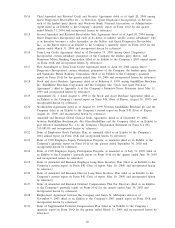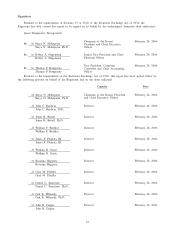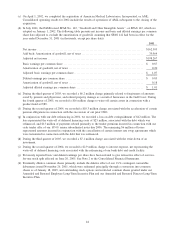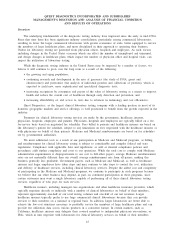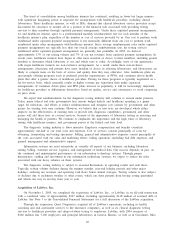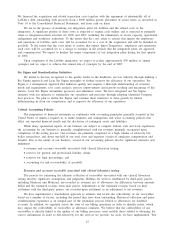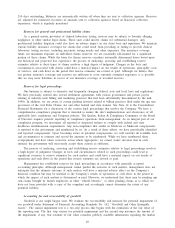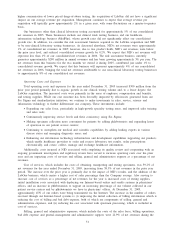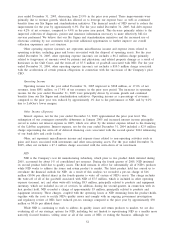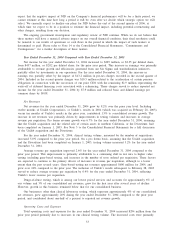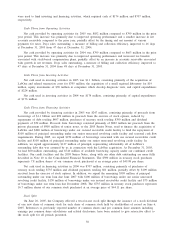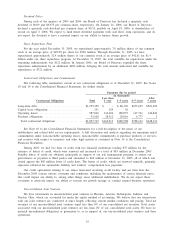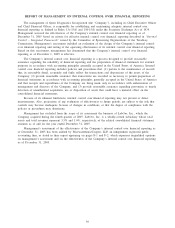Quest Diagnostics 2005 Annual Report Download - page 66
Download and view the complete annual report
Please find page 66 of the 2005 Quest Diagnostics annual report below. You can navigate through the pages in the report by either clicking on the pages listed below, or by using the keyword search tool below to find specific information within the annual report.210 days outstanding. Balances are automatically written off when they are sent to collection agencies. Reserves
are adjusted for estimated recoveries of amounts sent to collection agencies based on historical collection
experience, which is regularly monitored.
Reserves for general and professional liability claims
As a general matter, providers of clinical laboratory testing services may be subject to lawsuits alleging
negligence or other similar legal claims. These suits could involve claims for substantial damages. Any
professional liability litigation could also have an adverse impact on our client base and reputation. We maintain
various liability insurance coverages for claims that could result from providing or failing to provide clinical
laboratory testing services, including inaccurate testing results and other exposures. Our insurance coverage
limits our maximum exposure on individual claims; however, we are essentially self-insured for a significant
portion of these claims. While the basis for claims reserves considers actuarially determined losses based upon
our historical and projected loss experience, the process of analyzing, assessing and establishing reserve
estimates relative to these types of claims involves a high degree of judgment. Changes in the facts and
circumstances associated with claims could have a material impact on our results of operations, principally costs
of services, and cash flows in the period that reserve estimates are revised or paid. Although we believe that
our present insurance coverage and reserves are sufficient to cover currently estimated exposures, it is possible
that we may incur liabilities in excess of our insurance coverage or recorded reserves.
Reserves for legal proceedings
Our business is subject to extensive and frequently changing federal, state and local laws and regulations.
We have previously entered into several settlement agreements with various government and private payers
relating to industry-wide billing and marketing practices that had been substantially discontinued by the mid-
1990s. In addition, we are aware of certain pending lawsuits related to billing practices filed under the qui tam
provisions of the civil False Claims Act and other federal and state statutes. See Note 14 to the Consolidated
Financial Statements for a discussion of the various legal proceedings that involve the Company. We have a
comprehensive compliance program that is intended to ensure the strict implementation and observance of all
applicable laws, regulations and Company policies. The Quality, Safety & Compliance Committee of the Board
of Directors requires periodic reporting of compliance operations from management. As an integral part of our
compliance program, we investigate all reported or suspected failures to comply with federal and state
healthcare reimbursement requirements. Any non-compliance that results in Medicare or Medicaid overpayments
is reported to the government and reimbursed by us. As a result of these efforts, we have periodically identified
and reported overpayments. Upon becoming aware of potential overpayments, we will consider all available facts
and circumstances to estimate and record the amounts to be reimbursed. While we have reimbursed these
overpayments and have taken corrective action where appropriate, we cannot assure investors that in each
instance the government will necessarily accept these actions as sufficient.
The process of analyzing, assessing and establishing reserve estimates relative to legal proceedings involves
a high degree of judgment. Changes in facts and circumstances related to such proceedings could lead to
significant revisions to reserve estimates for such matters and could have a material impact on our results of
operations and cash flows in the period that reserve estimates are revised or paid.
Management has established reserves for legal proceedings in accordance with generally accepted
accounting principles. Although management cannot predict the outcome of such matters, management does not
anticipate that the ultimate outcome of such matters will have a material adverse effect on the Company’s
financial condition but may be material to the Company’s results of operations or cash flows in the period in
which the impact of such matters is determined or paid. However, we understand that there may be pending qui
tam claims brought by former employees or other “whistle blowers’’, or other pending claims as to which we
have not been provided with a copy of the complaint and accordingly cannot determine the extent of any
potential liability.
Accounting for and recoverability of goodwill
Goodwill is our single largest asset. We evaluate the recoverability and measure the potential impairment of
our goodwill under Statement of Financial Accounting Standards No. 142, “Goodwill and Other Intangible
Assets’’. The annual impairment test is a two-step process that begins with the estimation of the fair value of
the reporting unit. The first step screens for potential impairment and the second step measures the amount of
the impairment, if any. Our estimate of fair value considers publicly available information regarding the market
49



